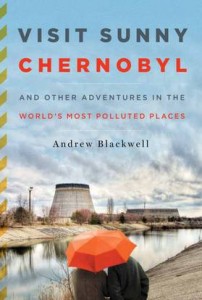
When Andrew Blackwell was researching his new book Visit Sunny Chernobyl, he contacted us to learn a little more about our work and about Blacksmith’s list of world’s worst polluted places. Turns out he was visiting some of these very same hotspots.
Now that the book is out, we heartily recommend that everyone pick up Blackwell’s unusual travel journal, which opens the door to a whole world that many people avoid.
Blackwell describes his book as a “love letter to neglected and reviled places.” What he has done is to reveal the beauty and human dignity that can rise above the threat of toxic pollution, and to reaffirm that these hotspots and the people who live there should not be ignored. The reality is that even though toxic pollution puts over 100 million people at risk, it remains one of the most under-reported global problems.
Look for Blackwell soon at a Blacksmith Pollution Talk event.
In the meantime, I recently reconnected with Blackwell and spoke to him about his environmental adventure.
Blacksmith: What has the response to your book been like?
Blackwell: It’s been really great. People often start out thinking it’s going to be another environmental screed, or just some more environmental horror stories. But it’s really not! It’s much more of a personal attempt to get to know people and places under environment threat—to go beyond horror stories or grossness to embrace and engage with places we might otherwise just be disgusted by. And to hear from readers who really got that message—not to mention groups like Blacksmith—is really gratifying.
Blacksmith: What did you learn about toxic pollution and the people living in those places?
Blackwell: More than anything, that polluted places don’t always look polluted. I think sometimes we expect a really bad environmental problem—and the health costs that go with it—to be really dramatic. And that’s often not so. But even though this makes it harder (for a layperson) to identify the severity of a problem, I think it’s a good thing. It’s important to realize that places with severe pollution are a lot less different from our own cities and homes than we might imagine. And that makes it so much more obvious why these places are worth fighting for.
Blacksmith: Did you know much about toxic pollution before you went on your journey?
Blackwell: Some, but not a huge amount. That was one of the best parts of the journey: learning about the details of all these issues as I made my way through each location. I think of it as having been on a series of the best science class field trips ever.
Blacksmith: How did you decide on your itinerary?
Blackwell: I wanted to get a nice range of different parts of the world and different environmental issues. So although the former Soviet Union has many, many interesting polluted places, once I’d been to Chernobyl I moved on to other parts of the world. (Similarly, I didn’t revisit the subject of radioactive contamination.) And while it might sound strange, I also tried to think like a tourist—about what kinds of activities and sights a particular location might offer. The whole idea wasn’t just to investigate pollution, but to have an adventure, to meet all kinds of different people, and tell the personal story of this great environmental odyssey that I’d set myself to.
Blacksmith: Did you see a difference between the sites you visited in the parts of the world where Blacksmith does cleanup, and the locations you visited in the “developed” world?
Blackwell: A lot less than you might think. For one thing, whether in China or in Texas, I met a lot of people who felt they had no choice but to live with toxic pollution—unless they wanted to leave their livelihoods or their homes. But on a brighter note, I also found that those same people often had a pretty nuanced understanding of the environmental problems they were living with. And that was true both in Ukraine and in India.
Blacksmith: Are you doing anything else related to pollution?
Blackwell: Lately I’m very interested in continuing my travels as a “pollution tourist” locally, exploring some of the Superfund sites in New York City, where I live. What holds true for the rest of the world holds true at home: in polluted places, any kind of engagement—even as a traveler or a tourist—is a healthy force.





